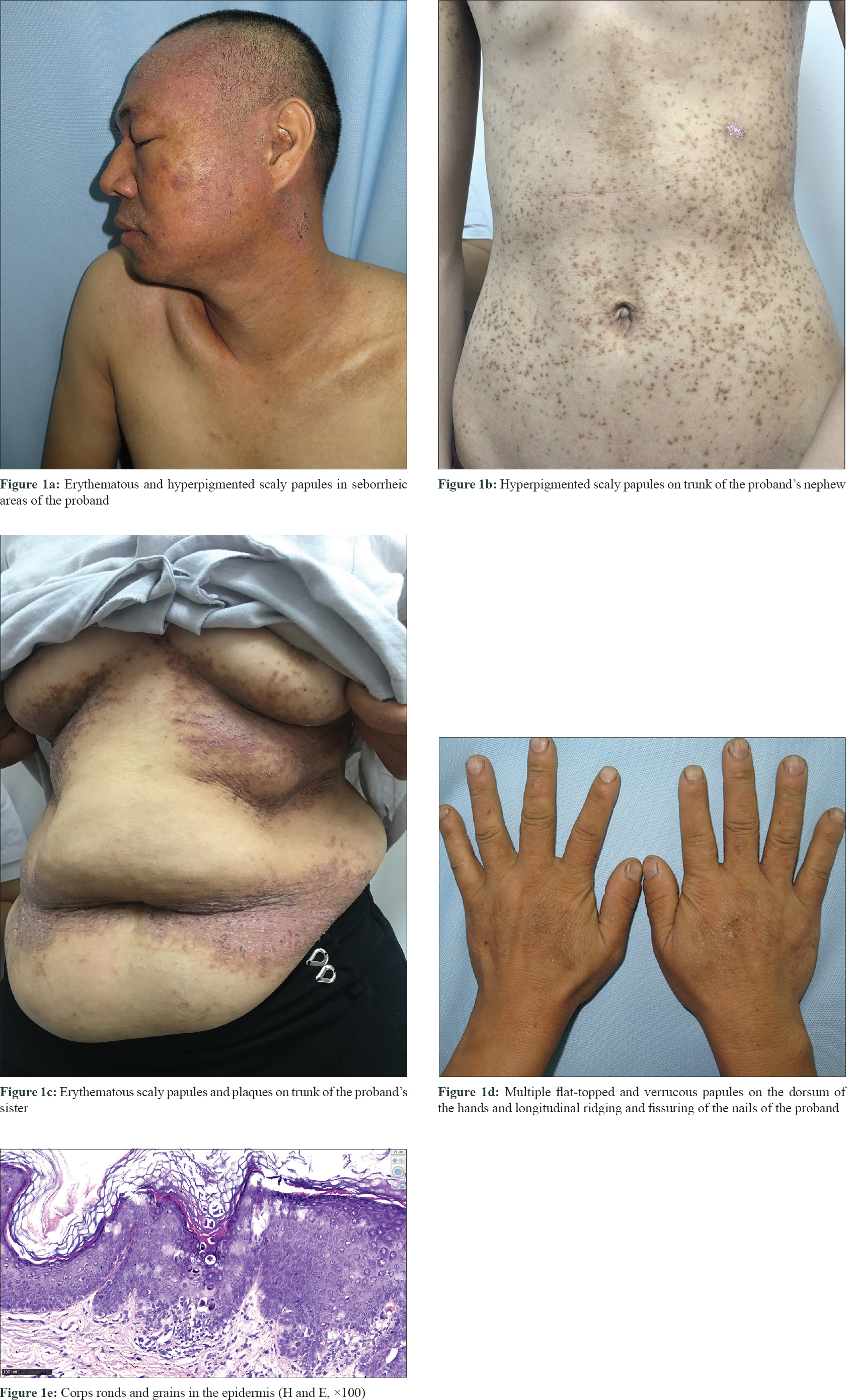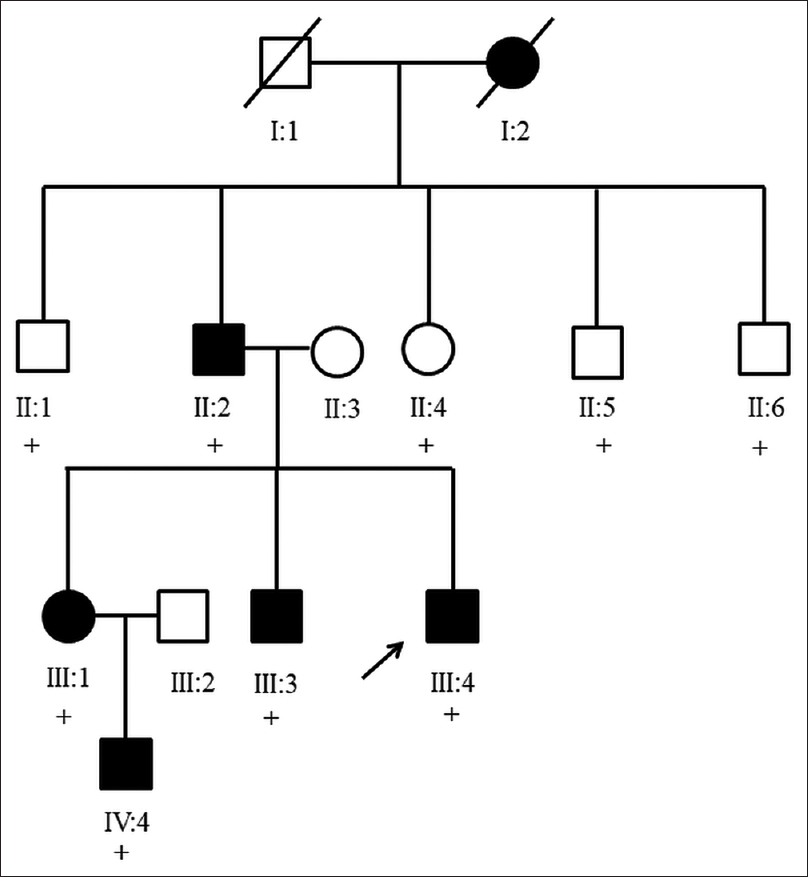Translate this page into:
Novel ATP2A2 mutation in a large Chinese pedigree with extensive Darier's disease
2 Department of Dermatology, The Third Affiliated Hospital of Anhui Medical University, The First People's Hospital of Hefei, Hefei, Anhui, China
Correspondence Address:
Birong Guo
Department of Dermatology, The Third Affiliated Hospital of Anhui Medical University, The First People's Hospital of Hefei, Hefei, Anhui
China
Jianfang Sun
Institute of Dermatology, Chinese Academy of Medical Sciences and Peking Union Medical College, Beijing
China
| How to cite this article: Zhang W, Wang C, Guo B, Sun J. Novel ATP2A2 mutation in a large Chinese pedigree with extensive Darier's disease. Indian J Dermatol Venereol Leprol 2020;86:318-321 |
Sir,
Darier's disease (OMIM 124200) is an autosomal dominant genodermatosis characterized by warty papules and plaques in seborrheic areas such as central part of trunk, flexures, scalp and face. Heat and sweating may exacerbate the disease. The mutations responsible for Darier's disease have been identified in the ATP2A2 gene on chromosome 12q23-24.1. This gene encodes the sarco/endoplasmic reticulum Ca2+ ATPase type-2 isoform (SERCA2), which transports Ca2+ from the cytosol into the endoplasmic reticulum lumen and plays a pivotal role in intracellular calcium signalling.
A 43-year-old Chinese man presented with extensive pruritic eruption mostly on seborrheic areas of 30 years duration. These lesions first developed on his face at the age of 13 and later progressed to involve trunk, scalp and flexures. Sun exposure and sweating aggravated his condition. He was born at full term and had no history of neuropsychiatric abnormalities. Multiple erythematous and hyperpigmented scaly papules were present on his scalp, face, neck and trunk [Figure - 1]a. Flat-topped and verrucous papules were present on the dorsum of his hands and nails showed longitudinal ridging and fissuring [Figure - 1]d. Oral mucosa was uninvolved. His sister and nephew also had a similar clinical presentation [Figure - 1]b and [Figure - 1]c. There were six individuals in his family, including four males and two females, affected with similar lesions[Figure - 2]. The other affected members of this family were diagnosed by dermatologists with histopathological confirmation [Figure - 1]e.
 |
| Figure 1: |
 |
| Figure 2: Genealogical tree of Darier's disease. “+” in pedigree indicates those who have undergone Sanger sequencing |
We carried out sequencing studies to find out the pathogenic gene of a large Chinese pedigree with severe Darier's disease. This study was approved by the ethics committee of Peking Union Medical College and conducted according to the principles of the Declaration of Helsinki. After obtaining informed consent from the proband, his parents, his sister and the son of his sister, ethylenediaminetetraaceticacid anticoagulated venous blood samples were collected from all participants. Genomic DNA was extracted from peripheral blood lymphocytes by standard procedures using Flexi Gene DNA kits (Qiagen, California, USA). The primer of all coding exon and intron-exon boundaries of ATP2A2 was designed using the web-based version of the Primer 3.0 program (http://www. genome. wi. mit. edu/cgibin/primer/primer3_www. cgi). The primer was amplified by polymerase chain reaction (PCR). After the amplification, the PCR products were purified with a QIAquick PCR purification kit (Qiagen) and directly sequenced on ABI PRISM 3730 automated sequencer (Applied Biosystems). Sequence comparisons and analysis were performed by Phred-PhrapConsed program, V.12.0. As a result, sequence analysis of the ATP2A2 gene revealed a novel heterozygous mutation in ATP2A2 (exon 19: c. 2747C > T: Ser916Phe) [Figure - 3]. A subsequent search of the published work in PubMed (www. ncbi. nlm. nih. gov/pubmed/) and ATP2A2 sequence information (University of California Santa Cruz Genome Browser Home [http://genome.ucsc.edu/]) led to the identification of this mutation as novel.
 |
| Figure 3: Sanger sequencing revealed a heterozygous mutation in ATP2A2 (exon 19:c.2747C>T: Ser916Phe) |
In addition, we sequenced another four affected and four unaffected family members from this family. We identified the same missense mutation in all affected members but not in unaffected members. Meanwhile, we sequenced the mutation in additional 200 unrelated, ethnically and geographically matched healthy controls and found that the mutation was absent in these 200 subjects.
Darier disease is a rare skin condition with autosomal dominant inheritance that manifests in childhood or adolescence. More than 248 pathogenic mutations have been described so far throughout the gene including missense, nonsense, substitution, insertion and deletion involving both frame-shift and inframe.[1],[2],[3] In general, these mutations are scattered over the entire ATP2A2 gene, without any clearly identified genotype–phenotype correlation. ATP2A2 mutations could be associated with acrokeratosis verruciformis of Hopf.[4] Nail changes include longitudinal red and/or white lines, longitudinal ridging, fissuring and wedge-shaped subungual hyperkeratosis. The nails are brittle and tend to break distally, forming V-shaped notches.[5] This study showed a novel heterozygous mutation in ATP2A2 (exon 19: c.2747C>T: Ser916Phe) in a large Chinese pedigree, which was linked with a phenotype of extensive Darier's disease as well as multiple flat-topped verrucous plaques on the dorsum of the hands, a presentation of acrokeratosis verruciformis. These results contribute to expand the database of ATP2A2 mutations and identify the genotype–phenotype correlation in the future.
Acknowledgement
We are most grateful to all the patients with Darier's disease and their family members for their support of this study.
Declaration of patient consent
The authors certify that they have obtained all appropriate patient consent forms. In the form, the patients have given their consent for their images and other clinical information to be reported in the journal. The patients understand that name and initials will not be published and due efforts will be made to conceal identity, but anonymity cannot be guaranteed.
Financial support and sponsorship
This work was funded by the Fundamental Research Funds for the Central Universities (2016RC320006), the CAMS Innovation Fund for Medical Sciences (CIFMS2017I2M1017), the General Program of the National Natural Science Foundation of China (No. 81301352) and the Anhui Provincial Hefei city Program (hwk2017yb008).
Conflicts of interest
There are no conflicts of interest.
| 1. |
Ren YQ, Gao M, Liang YH, Hou YX, Wang PG, Sun LD, et al. Five mutations of ATP2A2 gene in Chinese patients with Darier's disease and a literature review of 86 cases reported in China. Arch Dermatol Res 2006;298:58-63.
[Google Scholar]
|
| 2. |
Zhang GL, Li M, Du XF, Shi HJ, Shao MH, Mu HJ, et al. Anovel point mutation at donor splice-site in intron 18 of ATP2A2 gene resulting in the insertion of 27 nucleotides into the mature mRNA in a Chinese patient with severe Darier's disease. J Dermatol Sci 2011;64:72-5.
[Google Scholar]
|
| 3. |
Li M, Higashi N, Nakano H, Saeki H. An ATP2A2 missense mutation in a Japanese family with Darier disease: A case report and review of the Japanese Darier disease patients with ATP2A2 mutations. J Nippon Med Sch 2017;84:246-50.
[Google Scholar]
|
| 4. |
Dhitavat J, Macfarlane S, Dode L, Leslie N, Sakuntabhai A, MacSween R, et al. Acrokeratosis verruciformis of hopf is caused by mutation in ATP2A2: Evidence that it is allelic to Darier's disease. J Invest Dermatol 2003;120:229-32.
[Google Scholar]
|
| 5. |
Onozuka T, Sawamura D, Yokota K, Shimizu H. Mutational analysis of the ATP2A2 gene in two Darier disease families with intrafamilial variability. Br J Dermatol 2004;150:652-7.
[Google Scholar]
|
Fulltext Views
3,626
PDF downloads
2,293





